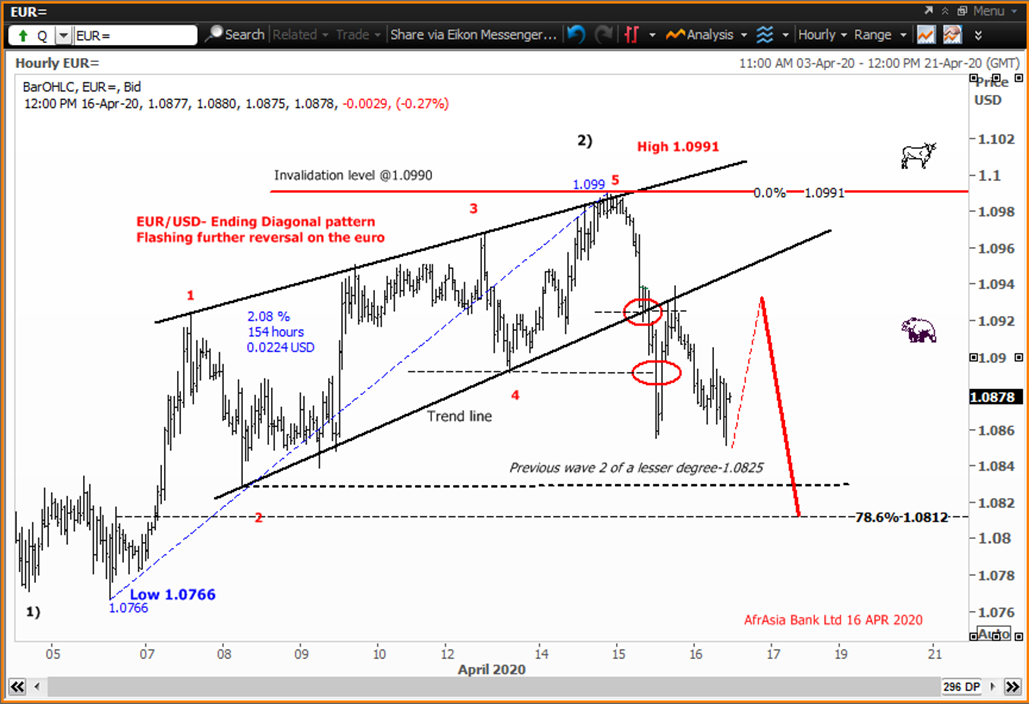EUR/USD losing grip, Ending Diagonal pattern signaling strong reversal!!
"It is not the strongest or the most intelligent who will survive but those who can best manage change."
- Charles Darwin
After rising relentlessly from the first week of April, the Single currency fell sharply from a two-week highs of $1.0990 to $1.0854 on Wednesday undermined by disappointment in markets over a half-trillion-euro coronavirus rescue plan agreed by euro zone finance ministers late last week coupled with dismissal U.S retail and Factory data which sparked flight to the safety of the greenback.
Indeed, after two-day stressing discussions, last week, EU finance ministers finally agreed on a €540 billion stimulus relief package via the European Stability Mechanism, meant to support member stated. Basically, cheap loans through the so-called “corona bonds” to governments, allowing them to subsidize wages so that companies can cut working hours rather than jobs, and a plan for the European Investment Bank to step up lending to companies.
Now, the epicenter of the debate in the European markets, post Easter holidays, appear to have shifted away from the developments of the coronavirus to the hard recovery that many economies will face once the COVID-19 crisis is over. In this regard, on Tuesday 14th of April, the International Monetary Fund (IMF) in its world economic outlook projected the global GDP to contract around 3% this year and forecasted that the world may see the deepest recession, since the Great Depression in the early 1930s that lasted until about 1939.
Technical Outlook-Ending Diagonal pattern signaling strong reversal on the Euro
Early in April 2020, on the EUR/USD, following the low printed at $1.0766, we were looking for an upside pull-back near 1.0875 before the pair resumes its downturn near $1.0700. However, from $1.0875 the pair never look back again, but creeped higher making one record high after another to finally reach a high of $1.0990 late on Tuesday 14th of April, gaining almost 2.08% on the way up.
On the hourly Chart below, the overall wave pattern on EUR/USD during 6th and 15th April 2020 adheres to the shape of an Ending Diagonal pattern. An Ending diagonal is a special type of Elliott Wave pattern which usually indicates exhaustion of the larger movement when markets players have been too far too fast on a currency pair. This pattern is rare in markets and it usually takes the form of a rising wedge in two converging trend line and is followed by a swift and sharp reversal, retracing at least back to the level where the diagonal began and possibly further. Researchers indicate that the move back to where the diagonal began takes about one-third to one and half of the time it took for the diagonal to unfold and it usually makes a zig-zag retracement of 78.6% from the previous impulse.
Here is a close-up view of this Diagonal on an hourly chart, the EUR/USD has pierced the 2-4 trend line and previous wave 4 of a lesser degree at $1.0890, suggesting that the termination point on the Diagonal was stuck at $1.0990 and further downward pressure could be on the cards for the battered euro.

On the downside, the current weakness can see the Fiber continuing on its downward trajectory with bears setting their eyes on the previous wave 2 of the Diagonal pattern at $1.0827 followed by 78.6% retracement at $1.0821. A break through previous low of $1.0766 would open the door for further decline near $1.0377.
On the flipside, resistance can emerge near $1.0940 and a close above 1.0990/1.1000 area should open the door for extra gains and could allow for a visit to recent tops near $1.1145.
Disclaimer: This communication is provided for information and discussion purposes only. Unless otherwise indicated, it does not constitute an offer or recommendation to purchase or sell any financial instruments or other products. AfrAsia Bank does not guarantee or warrant the accuracy, reliability, completeness of the information in this publication.
- Tariff Guide - Non Resident
- Tariff Guide - Resident
- Bank of Mauritius Template on Fees, Charges and Commissions
- Mauritius exits EU list of High-risk third countries on 13 March 2022
- MBA Communique - Mauritius exits UK High-Risk Third Countries list
- MBA Code of Ethics and of Banking Practice
- MBA Communiqué - FATCA
- MBA - KYC Policy Booklet
